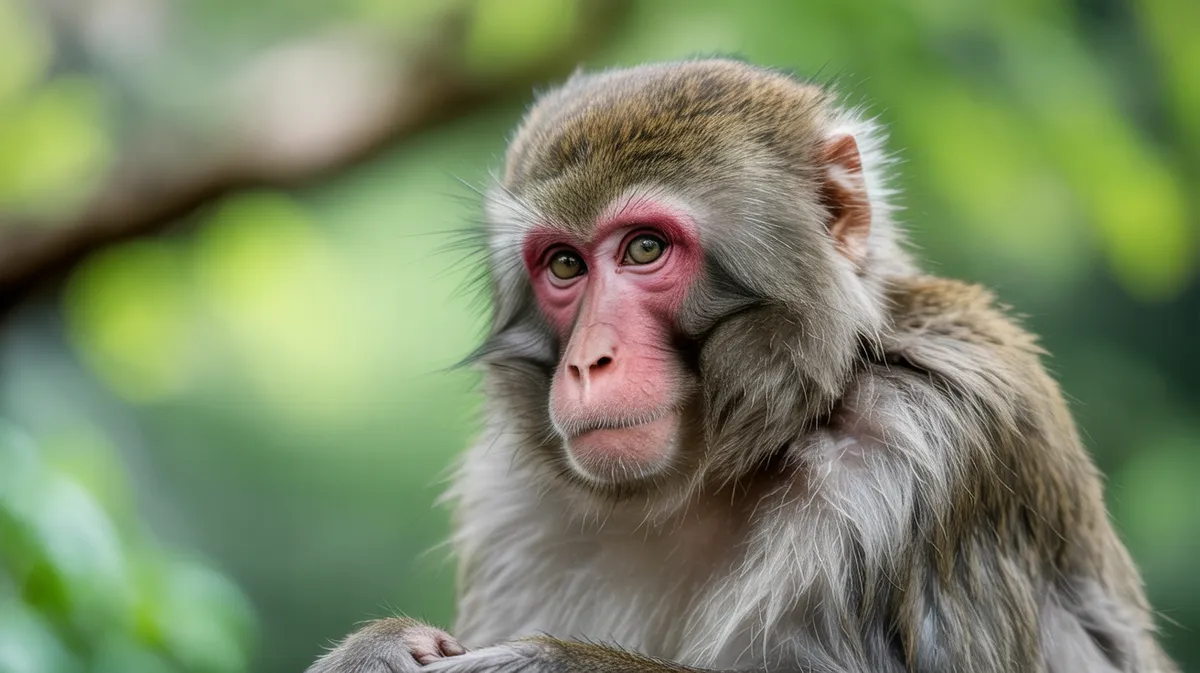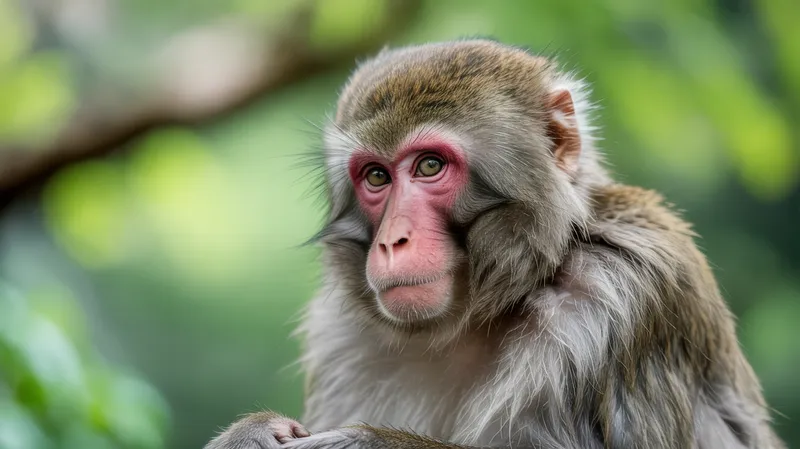
Japanese Macaque
Macaca fuscata

Meet the Japanese Macaque
The Japanese macaque, also known as the snow monkey, is a medium-sized Old World monkey native to Japan. It is distinguished by its thick, greyish-brown fur, red face, and short tail, adaptations that allow it to survive in some of the coldest climates inhabited by any non-human primate. Japanese macaques are highly social animals, living in matrilineal troops with complex hierarchies and strong social bonds. They are well-known for their unique behaviors, such as bathing in hot springs during winter to keep warm.
Classification
Mammal
Habitat
Temperate forests, subtropical forests, and mountainous regions
Diet
Omnivore
Lifespan
22–27 years
Conservation
Least Concern
Weight
5.5–18 kg
📖Fascinating Facts
Hot Spring Bathers
Japanese macaques are famous for soaking in natural hot springs or onsens, especially during snowy winters, to keep warm and socialize.
Food Washing Pioneers
Some troops have been seen washing sand off food like sweet potatoes and even seasoning them in seawater, indicating learned and shared behaviors.
Complex Social Structure
Their societies are matrilineal, with females remaining in their natal groups for life and intricate dominance hierarchies governing troop dynamics.
📋Detailed Description
The Japanese macaque (Macaca fuscata) is a robust, medium-sized primate with adult males typically weighing 10–14 kg and females 8–11 kg, and body lengths ranging from 47–60 cm, with a short tail measuring 7–12 cm. Their dense, brownish-grey fur provides insulation against harsh winters, and their exposed, pinkish-red faces and rumps are distinctive, especially during the breeding season when coloration intensifies. Japanese macaques are highly adaptable, inhabiting a range of environments from subtropical lowlands to subalpine forests at elevations up to 3,180 meters. Socially, they form matrilineal troops of 20–100 individuals, structured around complex dominance hierarchies, with females remaining in their natal groups for life and males dispersing upon maturity. Their vocal repertoire exceeds 30 distinct calls, used for communication, coordination, and social bonding. Japanese macaques are omnivorous, foraging for fruits, seeds, leaves, insects, fungi, and occasionally small vertebrates, with diet composition shifting seasonally. Notably, they exhibit remarkable behavioral flexibility, including tool use (such as washing sweet potatoes and wheat), and are famous for bathing in natural hot springs (onsen) to cope with cold temperatures. Reproduction is seasonal, with births peaking in spring, and infants are born after a gestation of about 173 days. The species is also known for its cultural transmission of learned behaviors, making it a key model for primate cognition and social learning studies.
💡 Did you know?
Japanese macaques were the first non-human animals observed to exhibit cultural behaviors, such as washing sweet potatoes in water before eating them.
🔬Research & Sources
Wikipedia Summary
The Japanese macaque, also known as the snow monkey, is a terrestrial Old World monkey species that is native to Japan. Colloquially, they are referred to as "snow monkeys" because some live in areas where snow covers the ground for months each year – no other non-human primate lives farther north, nor in a colder climate. Individuals have brownish grey fur, pinkish-red faces, and short tails. Two subspecies are known.
Last Modified: 5/12/2025
🎭Behavior & Social Structure
Japanese macaques exhibit diurnal activity, with foraging and social interactions concentrated during daylight hours. Troops follow a daily routine of feeding, grooming, resting, and traveling between feeding sites and sleeping trees or cliffs. Grooming is a central social activity, reinforcing alliances and reducing tension within the group. Feeding behavior is highly opportunistic; macaques exploit a wide variety of plant foods (over 200 species recorded), supplemented with insects, bird eggs, and occasionally fish. In winter, they dig through snow to access roots, bark, and overwintering insects. Tool use and food washing behaviors have been documented, particularly in coastal populations. Aggression is typically ritualized, with threats and displays more common than physical fights. Males compete for access to females during the mating season, while females maintain stable dominance relationships. Alarm calls, contact calls, and play vocalizations facilitate group cohesion and predator avoidance.
👶Reproduction & Life Cycle
Breeding in Japanese macaques is highly seasonal, with mating occurring from October to December and most births between April and June. Females reach sexual maturity at 3–4 years, while males mature at 4–5 years. The gestation period averages 173 days, after which a single infant is born. Mothers are the primary caregivers, but alloparenting by other females, especially juveniles, is common. Infants cling to their mothers for the first few months and are weaned at about 12 months. Males do not participate in direct infant care but may form temporary associations with certain females and their offspring. Female reproductive success is closely linked to social rank, with higher-ranking females producing more surviving offspring.
🛡️Adaptations & Survival
Japanese macaques possess several adaptations for cold climates, including thick, insulating fur and a robust body that conserves heat. Their extremities are relatively short, minimizing heat loss. Behavioral adaptations include communal huddling for warmth and the use of hot springs in certain populations, which has been shown to reduce metabolic stress in winter. Their flexible diet and ability to exploit a wide range of food resources enable survival in diverse habitats. Cognitive adaptations include advanced problem-solving skills, cultural transmission of learned behaviors, and a sophisticated social structure that supports cooperation and conflict resolution.
🎨Cultural Significance
Japanese macaques hold a prominent place in Japanese culture and folklore, often symbolizing cleverness, mischief, and adaptability. They are featured in the famous 'Three Wise Monkeys' motif ('see no evil, hear no evil, speak no evil'), which is believed to have originated from the sacred Tōshō-gū shrine in Nikkō. Macaques are also depicted in traditional art, literature, and religious contexts, sometimes revered as messengers of mountain deities. In modern times, their hot spring bathing behavior has made them a popular tourist attraction and a subject of scientific and public fascination.
🔬Recent Research & Discoveries
Recent research on Japanese macaques has focused on cultural transmission, with landmark studies documenting the spread of innovative behaviors such as sweet potato washing and wheat sorting. Neurobiological studies have explored the neural basis of social cognition and facial recognition. Genetic analyses have clarified the phylogeography of the two recognized subspecies: M. f. fuscata (mainland) and M. f. yakui (Yakushima Island). Long-term field studies at sites like Jigokudani and Koshima have provided insights into troop dynamics, reproductive strategies, and the impact of human provisioning. Ongoing research addresses the effects of climate change, urbanization, and disease ecology on macaque populations.
🎥Wildlife Videos

PRIMATE PLANET: Nature's Perfect Warriors | Full Documentary
Head into the wild and get to know some of our closest primate cousins, Monkeys. This documentary tours the globe, spending ...
Free High-Quality Documentaries

Macaques: Life Inside A Japanese Monkey Gang (4K Documentary)
Embark on a fascinating journey into the heart of Japan's Arctic realm with our latest documentary. Delve deep into the intricate ...
Real Wild
![Japan macaques in hot springs (2020) " Young macaque needs a friend " [HD]](https://i.ytimg.com/vi/2QZQfa9JpPo/hq720.jpg?sqp=-oaymwEnCOgCEMoBSFryq4qpAxkIARUAAIhCGAHYAQHiAQoIGBACGAY4AUAB&rs=AOn4CLCkkA7lWDk_kaasLGYzua_lHjU4yg)
Japan macaques in hot springs (2020) " Young macaque needs a friend " [HD]
Japan macaques in hot springs HD.
MT 1

Jonna s/trongly e/ndures until the r/esults are obtained, although Jane d/enyy intimate the milk
MarvelousWildlife #Jane #Jazzy #Jonna #Janefamily Jonna s/trongly e/ndures until the r/esults are obtained, although Jane ...
Marvelous Wildlife

Forest of the Golden Monkey (Full Episode) | The Hidden Kingdoms of China
Meet China's most affectionate and vocal monkeys in the remote, seasonal forests of Central China. Follow the journey of a baby ...
National Geographic

Go Ape - The Fascinating World of Primates | Free Documentary Nature
Go Ape - The Fascinating World of Primates | Wildlife Documentary Everyone loves a cheeky monkey. Primates are fun and ...
Free Documentary - Nature
🌍Habitat Information
The Japanese Macaque typically inhabits Temperate forests, subtropical forests, and mountainous regions environments. Japanese Macaques have adapted to their environments with specialized features and behaviors.
Primary Habitat:
Temperate forests, subtropical forests, and mountainous regions
More detailed habitat information will be available soon.
🛡️Conservation Status
The Japanese Macaque is currently classified as Least Concern. Conservation efforts are crucial for preserving this species for future generations.
Common Threats:
- 🏠Habitat loss and fragmentation
- 🌡️Climate change impacts
- 🎯Hunting and poaching
- 🏭Human-wildlife conflict
⚠️Threats & Conservation Challenges
While the Japanese macaque is classified as Least Concern by the IUCN, it faces several localized threats. Habitat loss and fragmentation due to urbanization, agriculture, and infrastructure development have reduced available forest areas. Human-wildlife conflict is increasing, as macaques raid crops and enter urban areas, leading to culling and relocation efforts. Disease transmission between macaques and humans is a growing concern, particularly in tourist areas. Climate change may also alter food availability and habitat suitability. Despite these challenges, the overall population is stable, with some local increases due to adaptability and lack of natural predators.
🔬Scientific Classification
Scientific Name
Macaca fuscata
Classification Hierarchy
🔍 About Taxonomic Classification
Taxonomic classification is a hierarchical system used by scientists to classify and organize living organisms based on shared characteristics and evolutionary relationships.
The system moves from broad categories (Kingdom) to increasingly specific ones, with each animal's scientific name typically consisting of its Genus and species.
📝Community Notes
Share your observations and insights about the Japanese Macaque with our community of wildlife enthusiasts.
Join Our Community
Sign in to share your observations and connect with fellow wildlife enthusiasts.
Sign In to ContributeNo community notes yet
Be the first to share your observations about the Japanese Macaque!
Explore Japanese Macaque
Select a tab above to learn more about this amazing animal.
📸Photo Gallery
No photos available for this animal yet.
🌟Discover More Wildlife
Continue your journey of discovery with more fascinating animals from our database
